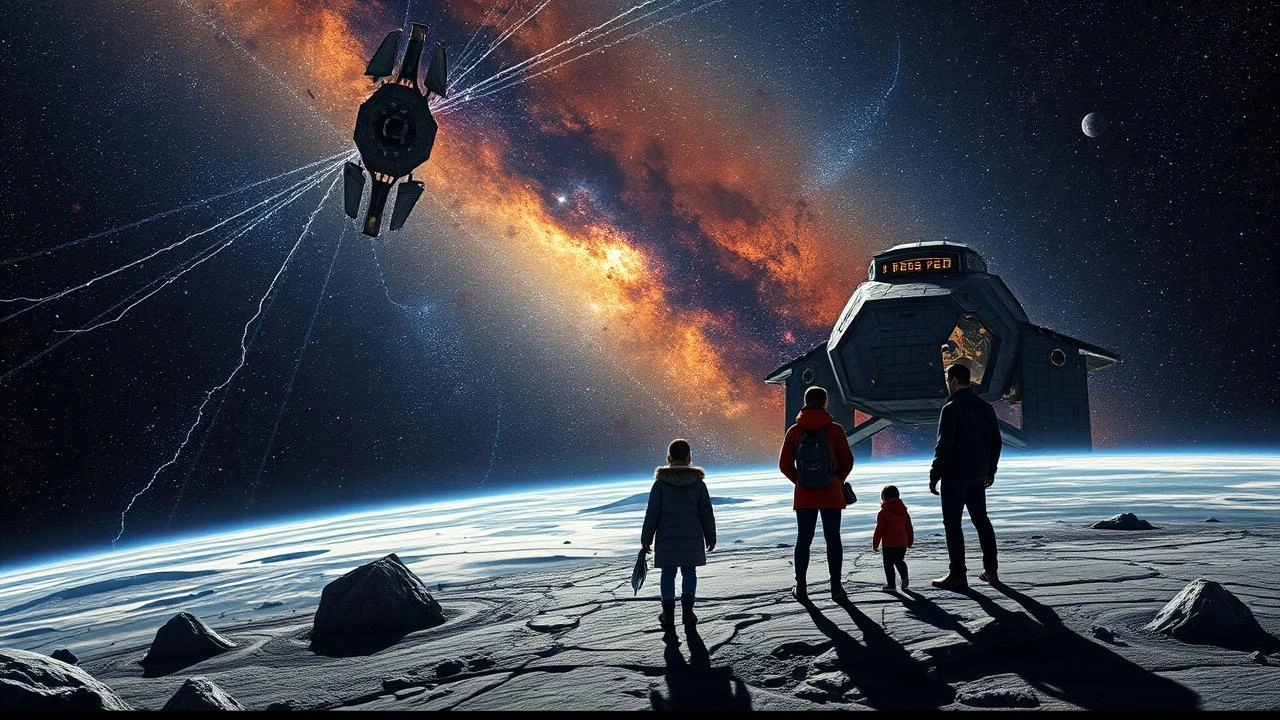The vast expanse of the cosmos has long been a realm of mystery and ambition, traditionally navigated by governmental space agencies. However, the dawn of the 21st century has ushered in a transformative era, marked by the rapid ascent of private space companies that are not only complementing but actively shaping the future of human spaceflight. Among these pioneers, Axiom Space stands out with its grand vision: to build the world’s first commercial space station and democratize access to low-Earth orbit (LEO). As the anticipation for Axiom Mission 4 (Ax-4) builds, it represents more than just another flight; it embodies a profound step towards a future where humanity, regardless of nationality, operates as a cohesive unit in space, fostering the idea that “the universe can be a family one day.”
The Rise of Commercial Spaceflight and Axiom Space’s Vision
For decades, space exploration was primarily the domain of superpowers, driven by geopolitical competition and scientific pursuit. Agencies like NASA, Roscosmos, and ESA led the charge, building monumental infrastructure like the International Space Station (ISS) – a testament to international collaboration. Yet, the high costs, complex political dynamics, and specific governmental objectives inherently limited access.
The emergence of commercial space companies like SpaceX, Boeing, and crucially, Axiom Space, has fundamentally altered this landscape. These private entities bring an entrepreneurial spirit, aiming for innovation, cost-effectiveness, and broader accessibility. Axiom Space, in particular, distinguishes itself with a strategic, multi-phased approach to developing a commercial platform in LEO. Their current model involves flying private astronaut missions (PAMs) to the ISS, utilizing existing infrastructure to gain experience, define operational protocols, and conduct cutting-edge research. These missions serve as crucial precursors to their ultimate goal: the deployment of the Axiom Station, a modular, independently operating commercial space station.
Axiom Space’s missions are pivotal in this transition. They are not merely tourist flights; rather, they are professionally managed expeditions involving trained astronauts, scientists, and even paying customers who contribute to the mission’s scientific and technological objectives. This model ensures that space access is no longer solely a national privilege but an opportunity for diverse individuals, researchers, and nations to actively participate in space exploration, sharing the benefits and the burdens.
Axiom Mission 4 (Ax-4): A Closer Look at the Next Frontier
While the specific crew and detailed manifest for Axiom Mission 4 (Ax-4) are still being finalized and announced closer to its targeted launch, it is poised to follow in the footsteps of its successful predecessors (Ax-1, Ax-2, Ax-3) and further solidify the commercial pathway to LEO. Each Axiom mission has built upon the last, refining operational procedures, expanding research capabilities, and fostering new partnerships.
Ax-4 is expected to carry a diverse, international crew, a hallmark of Axiom’s commitment to global collaboration. These crews typically consist of former professional astronauts, private researchers, and individuals representing various nations, all united by a common purpose: to contribute to humanity’s knowledge and presence in space. The mission objectives for Ax-4 will likely encompass several key areas:
- Advanced Scientific Research: Conducting experiments in microgravity across disciplines such as human physiology, materials science, biotechnology, and physics. These experiments often have direct applications for Earth-based industries, medicine, and environmental monitoring.
- Technological Demonstrations: Testing new technologies, hardware, and operational concepts vital for future space missions, including those related to the Axiom Station development.
- Educational and Cultural Outreach: Engaging with students and the public worldwide through live calls, educational videos, and sharing their unique experiences, inspiring the next generation of explorers.
- Commercial Activities: Facilitating specific commercial endeavors or research for private companies seeking to leverage the unique environment of space for product development or testing.
Like previous Axiom missions, Ax-4 will utilize a SpaceX Falcon 9 rocket and Dragon spacecraft for launch and return, underscoring the collaborative nature of the new space economy where different private entities contribute their specialized capabilities.
Building Bridges in Orbit: The “Family” Aspect
The subtitle “The universe can be a family one day” is not merely a poetic ideal but a practical aspiration driven by commercial spaceflight. When diverse crews from different nations and backgrounds share a confined space, working towards common scientific and exploratory goals, boundaries—geographical, cultural, and political—begin to dissolve. The ISS has long been a shining example of this, fostering unparalleled international cooperation even amidst terrestrial tensions. Commercial missions like Axiom’s extend this principle, making it more accessible and broadly distributed.
In the vacuum of space, shared challenges and mutual reliance transcend national identities. Astronauts become representatives of humanity, collaborating on tasks that benefit everyone on Earth. This shared human endeavor cultivates a sense of collective responsibility and unity. The training process itself breaks down barriers, as individuals from disparate fields and cultures learn to operate as a single, interdependent unit.
“The Earth is the cradle of humanity, but mankind cannot live forever in a cradle.” — Konstantin Tsiolkovsky
This profound statement by the father of rocketry encapsulates the essence of why humanity must venture beyond its home planet. As we do so, the challenges inherently force us to work together, fostering a global ‘family’ connected by the common pursuit of knowledge and exploration. Ax-4, with its probable international crew and global research implications, will further weave this tapestry of unity.
Scientific Endeavors and Their Earthly Benefits
The primary driver behind most commercial space missions, beyond the aspirational goal of expanding human presence, is the invaluable scientific research conducted in microgravity. The absence of gravity allows for observations and experiments impossible on Earth, leading to breakthroughs with direct terrestrial benefits.
Consider the following examples of research focus areas typical for Axiom missions, which Ax-4 is expected to continue and expand upon:
- Biomedical Research: Studying how the human body adapts to microgravity provides critical insights into aging, bone density loss, muscle atrophy, and cardiovascular health. These findings can lead to new treatments for conditions affecting millions on Earth, from osteoporosis to heart disease.
- Materials Science: Growing crystals or creating new alloys in microgravity can yield materials with superior properties – stronger, lighter, more efficient – that are impossible to synthesize under normal gravitational conditions. Applications range from advanced electronics to more durable aircraft components.
- Fluid Physics: Understanding fluid behavior in space contributes to more efficient industrial processes, improved drug delivery systems, and better thermal management in various technologies.
- Earth Observation and Climate Science: While not always the primary focus, missions to the ISS can contribute to Earth observation, providing data crucial for understanding climate change, natural disasters, and environmental health, benefiting all nations.
The data and discoveries generated from missions like Ax-4 are shared globally, contributing to the collective scientific knowledge base, reinforcing the idea of a shared human endeavor for the common good.
The Path to a Commercial Space Station (Axiom Station)
Axiom Space’s private astronaut missions are not standalone ventures; they are integral steps toward a much larger objective: the creation of the Axiom Station. This proposed commercial space station is envisioned to initially attach to the ISS as an independent module. Over time, as the ISS approaches its retirement, Axiom modules would detach, forming a free-flying, privately owned and operated orbital laboratory and habitation complex.
Ax-4 directly contributes to this long-term vision by:
- Testing Technologies: Demonstrating capabilities and systems that will be crucial for the standalone Axiom Station.
- Training Personnel: Providing invaluable operational experience for crew and ground support teams who will manage future commercial platforms.
- Building Client Relationships: Establishing a proven track record for conducting complex space missions for diverse international clients, laying the groundwork for a robust commercial LEO economy.
- Developing Markets: Proving the viability and demand for commercial research, manufacturing, and tourism in space.
The progression of Axiom missions provides a clear roadmap for this ambitious undertaking:
| Mission | Launch Vehicle | Crew Size | Primary Focus | Status |
|---|---|---|---|---|
| Ax-1 | SpaceX Falcon 9 | 4 | First All-Private Mission to ISS; Research & Outreach | Completed |
| Ax-2 | SpaceX Falcon 9 | 4 | Expanded Research; Saudi Astronauts | Completed |
| Ax-3 | SpaceX Falcon 9 | 4 | International Crew (Turkey, Italy, Sweden); Research | Completed |
| Ax-4 | SpaceX Falcon 9 | 4 (Est.) | Continued Internationalization; Advanced Research | Anticipated |
Each mission marks progress, not just in terms of technology, but in broadening the human footprint in space, making it a more inclusive and cooperative journey.
Challenges and the Future
Despite the revolutionary progress, the commercial space sector faces significant challenges. The costs of spaceflight remain substantial, regulatory frameworks are evolving, and the inherent risks of space operations necessitate stringent safety protocols. Furthermore, ensuring sustainable markets for commercial space activities is crucial for long-term viability.
However, the trajectory is undeniably upward. With increasing private investment, technological advancements, and a growing global interest in space, the future holds immense promise. We can anticipate more frequent missions, expanding access to LEO for an even wider array of nations and private entities, and eventually, the establishment of permanent commercial habitats. This will pave the way for humanity to live and work in orbit, fostering an even deeper sense of global citizenship.
Conclusion
Axiom Mission 4 is more than a technical endeavor; it is a cultural and philosophical step forward. By facilitating diverse crews and shared scientific pursuits, it reinforces the powerful idea that space is a common heritage, and its exploration is a collective human destiny. In a world often divided, the collaborative spirit fostered by commercial space missions like Axiom’s offers a compelling vision of unity. As more individuals from various corners of the globe venture into the cosmos, driven by curiosity and a shared desire for knowledge, we move closer to the realization that, indeed, “the universe can be a family one day”—a family united not by borders on Earth, but by the boundless potential of the stars.
Frequently Asked Questions (FAQs)
Q1: What is Axiom Space’s main goal? A1: Axiom Space’s primary goal is to build and operate the world’s first commercial space station, the Axiom Station, and to open private and national access to low-Earth orbit for research, manufacturing, and exploration.
Q2: How are Axiom missions different from traditional governmental space missions? A2: Axiom missions are commercial ventures, funded by private entities and nations, providing access to space for private astronauts, researchers, and commercial clients, whereas traditional governmental missions are funded and operated by national space agencies for specific national objectives. Axiom missions operate in collaboration with existing governmental infrastructure like the ISS.
Q3: What kind of research is conducted on Axiom missions? A3: Axiom missions conduct a wide range of scientific experiments in microgravity, including human health studies, materials science, biotechnology, physics experiments, and technology demonstrations, often with direct applications for life on Earth.
Q4: Will Axiom Space eventually replace the International Space Station (ISS)? A4: Axiom Space aims to provide a continuous human presence in low-Earth orbit after the ISS is decommissioned. Initially, Axiom modules will attach to the ISS, and later, they are designed to separate and operate as a standalone commercial space station.
Q5: How does Axiom Mission 4 contribute to the idea of “space as a family”? A5: Ax-4 contributes by bringing together a diverse, international crew to work collaboratively on shared scientific and exploratory goals, transcending national boundaries and fostering a sense of unified human endeavor in space, illustrating that cooperation is key to future space exploration.
Space mission Axiom 4: The universe can be a family one day






